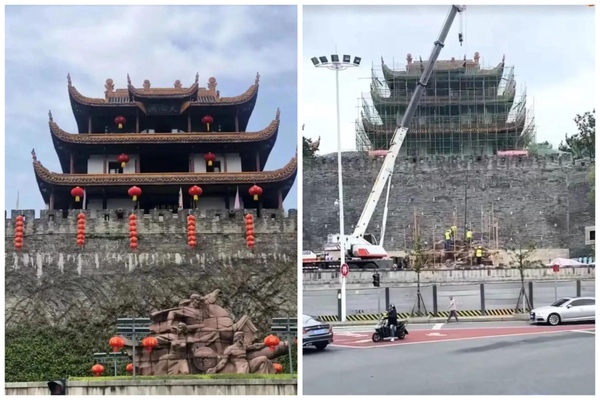Recently, online discussions were sparked as statues related to uprisings and peasant movements were removed in both Beijing’s Changping District and Changsha. The Li Zicheng statue in Changping District and the Taiping Heavenly Kingdom sculpture at Tianxin Pavilion in Changsha were taken down simultaneously, leading to heated debates online regarding these figures being labeled as “rebels.”
In Changsha, news of the removal of the Taiping Army sculpture outside Tianxin Pavilion quickly spread online. Videos circulating on Weibo showed the dismantling of the large-scale Taiping Heavenly Kingdom statue titled “Soul of the Taiping Army” in the famous scenic area of Tianxin Pavilion in Changsha, Hunan, known as the birthplace of the Xiang Army.
On May 26th, a reporter from The Paper contacted the Tianxin District Government office in Changsha to inquire about the situation. Officials stated that the sculptures of Taiping Army soldiers in the Tianxin Pavilion area were temporarily relocated as part of ongoing renovations in the scenic spot.
Similarly, the statue of Li Zicheng, which had stood at the Changping District’s Xiguan Roundabout for 30 years, was recently removed. According to a report by the Beijing Daily on May 24th, the Li Zicheng statue is planned to be relocated to the “Chuangwangzhai” scenic area in Shannan County, Shangluo City, Shaanxi Province.
Historical records show that Li Zicheng, originally from Mizhi County in Shaanxi, was a former postal officer in northern Shaanxi. He participated in the uprising after being laid off as a postal officer during the reign of the Chongzhen Emperor in the Ming Dynasty. Li Zicheng later proclaimed himself as the king of the rebellion and became one of the leaders of the late Ming Dynasty peasant uprising, leading his forces to destroy the main Ming army in Henan. In 1644, he declared himself emperor in Xi’an, established the Great Shun Dynasty, and later attacked Beijing, leading to the downfall of the Ming Dynasty after Chongzhen Emperor’s suicide. However, Li Zicheng was defeated by Qing troops the following year.
The removal of statues related to the Taiping Heavenly Kingdom and Li Zicheng, associated with peasant movements and uprisings, has sparked discussions among netizens regarding the authorities’ actions.
Travel blogger and Weibo influencer “Traveler from the Land of Changbai Clouds” remarked, “Coincidentally, even the statue of Li Zicheng has returned to his hometown recently.”
A netizen named “Yitian Xingming” expressed, “Beijing moved the Li Zicheng statue, and the Taiping Army sculpture outside Changsha’s Tianxin Pavilion has been removed! What is the significance of these removals? Statues symbolize history and carry profound meanings for reflection and education. However, relocating statues should be carefully considered. Why move them? What impact will leaving the statues in place have? These concerns of the public should be clearly explained to avoid misunderstandings.”
Some netizens commented, “Lately, both the Li Zicheng statue at Xiguan Roundabout in the capital and the Taiping Heavenly Kingdom relief at Tianxin Pavilion in Changsha have been taken down. The simultaneous occurrence of these events raises speculation. Deleting everything related to peasant uprisings. Feeling guilty. Haha, Taiping in the south and Zicheng in the north, the ‘rebels’ are having a tough time. Although these figures are heroes in our history textbooks for peasant uprisings, they were considered rebels against the ruling dynasty at that time.”

